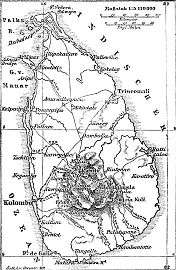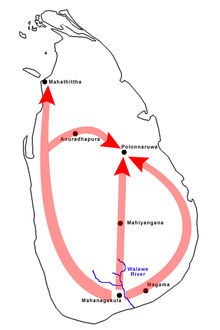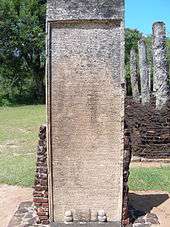Chola rule in Sri Lanka
| Historical states in present-day Sri Lanka |
|---|
 |
|
1017–1070 |
The period of Chola rule in the island of Sri Lanka began in the 2nd BCE with Manu Needhi Cholan who upon capturing the throne became king of the Anuradhapura Kingdom.[1] In 993 AD, Raja Raja Chola sent a large Chola army which conquered the Anuradhapura Kingdom, in the north, and added it to the sovereignty of the Chola Empire.[2] The whole or most of the island was subsequently conquered and incorporated as a province of the vast Chola empire during the reign of his son Rajendra Chola.[3][4][5][6]
The Chola rule which lasted for eight decades in the island, would be overthrown in 1077 through a rebellion led by Vijayabahu I one of the dispossessed Sinhalese monarchs. The Cholas fought many subsequent wars and attempted to reconquer Anuradhapura as the Sinhalese monarchs were allies of their arch-enemies, the Pandyas.
Conquest

Manu Needhi Cholan
Manu Needhi Cholan, also known as Ellalan was according to the chronicle Mahavamsa described as " A Damila of noble descent.. from the Chola Country".[7] Also mention in the Tamil epics Silappatikaram and Periya Puranam, he was often referred to as a "Just King" and thus has his name been used as a metaphor for justice and fairness in Tamil literature. Killing Asela of Anuradhapura, establishing himself as a sole ruler of Rajarata[8] Losing the battle to Dutugamunu, Ellalan died in 161 BCE.[9]
Raja Raja Chola I
The tirumagal inscription of Raja Raja Chola dated to 993 AD first mentions Anuradhapura among the king's conquests. Taking advantage of a civil war which had caused the Sinhalese monarch Mahinda V to flee to the south-east province of Anuradhapura known as Ruhuna, Raja Raja Chola invaded Anuradhapura sometime between 991 and 993 AD and conquered the northern part of the country and incorporated it into his kingdom as a province named "Mummudi-sola-mandalam" after himself.[2] The capital was at Polonnaruwa which was renamed "Jananathamangalam".[2]
Rajendra Chola I
In the year A.D.1014 Rajaraja Chola died after twenty nine years of rule, and was succeeded by his son the Rajendra Chola I on the throne of the Chola Empire. As per the Sinhalese Buddhist chronicle Mahavamsa, the conquest of Anuradhapura was completed by his son Rajendra Chola I in the 36th year of the reign of the Sinhalese monarch Mahinda V, i.e. about 1017–18.[10] According to the Karandai plates, Rajendra Chola led a large army into Anuradhapura and captured Mahinda's crown, queen, daughter, vast amount of wealth and the king himself whom he took as a prisoner to India.[10] The whole of Anuradhapura including the south-eastern province of Ruhuna were incorporated into the Chola Empire.[10]
Administration
Founding of Janathamangalam (Polonnaruwa)
Following the fall of Anuradhapura, the northern part of the island became a Chola province under the name Mummudi Chola Mandalam. The Cholas then founded a new capital at Janathamangalam (present-day Polannauwa) to the south-east of Anuradhapura.[3] The capital was the home to the Chola reign in the island that would last for close to a century and consequently would continue to thrive as the capital of the Kingdom of Polonnaruwa.
Establishment of trade settlements
During this period of Chola imperialism, the Tamil trading guilds Thisaiayiratthu Annuruvar also known as the Nanadesis, the Valanjiyar and the Nagaratthar who were already trading in Anuradhapura further increased their activities in the Island.[3][10]
Several mercantile towns were established across the island. The village of Manhottam alias Manthai, the closest link to Chola warriors of the mainland was developed into an important seaport city with many highways. The Chola Officers also built an irrigation tank near Iluppaikkadavai known as Cholamandalakkulam, north of Mannar.[10]
Coinage
Rajaraja during his rule of north Anuradhapura issued gold coins with the legend "Sri Rajaraja" inscribed on them. These were equivalent to ten kalanju or units of gold. There were also coins issued in base metal having the same legend Rajaraja. He also issued a base gold coin called the Madai, and the coin too bore his name Sri Rajarja in Nagari letters.
Rajendra during his rule of whole of Anuradhapura, issued gold coinage with the legend "Yuddha Malla" inscribed on them referring to him as a great warrior.[11]
Chola Samasthanam
Rajendra Chola appointed one of his sons as the viceroy in Anuradhapura with the title Ilangaiyarkku Iraivan who was also known as Chola Ilangeswaren alias Sri Sangapanmar. The region in Polonnaruwa where he resided and ruled was known as Chola Samasthanam (Solasamasthanaya of Polonnnaruwa).[2]
Culture
Religion
During the period of their governance, the Chola officials as well as Tamil traders built many temples of worship of Siva, many in the Northern half of the island. There is also documented evidence regarding Chola contributions to ancient Tamil Saivate temples such as Trincomalee and Mannar.[2][12]
A Siva temple was built at Jananathamangalam also known as Jananathapuram in the province of Nigarili Cholavalanadu alias Pulainari, and was named as Vanavanmadevi Iswarem after the queen of Raja Raja - 1. They built another Siva temple at Padaviya in the Anuradhapura district and named it as Ravikulamaanikka Iswarem after one of the titles of Rajaraja. Many Chola officials and traders around fifteen of them have made endowements to this temple, and Chenkulavan Katampan being one of them made donations in the year A.D.1005. Another Siva Temple was built at Padaviya and was named as Uththamar Koyil. There was yet another Siva temple constructed at Atakade in the Anuradhapura district and named as Uththama Chola Iswarem after the Rajarja's predecessor to the Chola throne. Chola officials also established settlements of Brahmin priests on the lands of Rajavichadira valanadu covering the present Kantalai in the Trincomalee district, and named it as Rajaraja Chathurvedimangalam.[2]
The region comprising Mathottam in Mannar alias Arunmolideva Valanadu was renamed as Rajarajapuram, and a Siva temple was constructed by Nallur Kilavan Taalikkumaran, a Chola Officer in Sri Lanka during this period, and was named as Rajaraja Iswarem. He also made arrangements to celebrate the annual festival of Vaikasi Visakam elaborately at this temple every year in the month of May. During this period Cholas built another Siva temple at Rajarajapuram alias Mathottam the present Mannar district and named it as Thiruraameeswarem. The artisans from the Chola country who came to Sri Lanka during this period were employed in the construction of these temples and in the casting of the bronze statues of Hindu deities for their shrines. The Cholas are also believed to have also reconstructing Buddhist temples, and expanded some of them such as Velgam Vihare also known as Sadda Vihare in preesnt-day Trincomalee district.[2]
Rebellions

Eleven years after the Chola conquest of Ruhuna, Mahinda V's son Vikramabahu I rose in rebellion. Taking advantage of uprisings in the Pandya kingdom and Kerala, Vikramabahu I massacred the Chola garrisons in Ruhuna and drove the 95,000-strong Chola army to Pulatthinagara. Soon afterwards, Vikramabahu crowned himself king of Ruhuna. Vikramabahu's mysterious death in 1041, however, brought an end to the war. His successor Mahalanakitti tried to drive the Cholas out of Anuradhapura but failed and hence, took his own life in disgrace. His successor Vijayabahu who ascended the throne in 1058 supported rebellions in the Chola province or Rajarattha in Northern Anuradhapura. The then Chola monarch Virarajendra responded by sending a large Chola army into Ruhuna and forcing it into subjugation. The Chola army plundered the capital Kajaragama and drove the king into flight. Vijayabahu, however, renewed his attacks on Chola garrisons after an interval of three years.
End of Chola rule

In 1070, during the reign of Kulothunga I, Vijayabahu attacked and captured Pulatthinagara and drove Cholas out of the city. Kulottunga sent a large army which engaged Vijayabahu in a pitched battle near Anuradhapura. The Cholas, initially succeeded in driving Vijayabahu to seek refuge in Vatagiri but Vijayabahu took Mahanagakula on the Walaweganga and conducted his resistance from there. Pulatthinagara and Anuradhapura fell to Vijayabahu and Mahatittha was soon occupied. Having liberated the whole of the island of Anuradhapura from Chola rule, Vijayabahu crowned himself king of Polonnaruwa in 1076-77.
Memorials
Raja Raja Chola (arul mozhi varman) commemorated his conquest of northern Anuradhapura by constructing a Shiva temple at Polonnaruwa. The Siva temple of Polonnaruwa which has survived to the present day is contemporaneous with the Brihadesswarar Temple at Thanjavur. One of his army officers Tali Kumaran constructed a Rajarajeswara Temple at Mantota. Raja Raja Chola's son and successor Rajendra I has left some inscriptions of his at the Shiva temple at Polonnaruwa. All Shiva and Vishnu temple remains found at Polonnaruwa also date from this time.
See also
Notes
- ↑ "The Five Kings - MAHASIVA, SURATISSA, ELARA, ASELA, SENA and GUTTIKA". mahavamsa.org. Retrieved 2016-05-10.
- 1 2 3 4 5 6 7 Sastri, pp 172–173
- 1 2 3 Chattopadhyaya, pp 7–9
- ↑ Indian History with Objective Questions and Historical Maps Twenty-Sixth Edition 2010, South India page 59
- ↑ Hermann Kulke; K Kesavapany; Vijay Sakhuja (2009). Nagapattinam to Suvarnadwipa: Reflections on the Chola Naval Expeditions to Southeast Asia. Institute of Southeast Asian Studies. pp. 195–. ISBN 978-981-230-937-2.
- ↑ Charles A. Gunawardena (2005). Encyclopedia of Sri Lanka. Sterling Publishers Pvt. Ltd. pp. 71–. ISBN 978-1-932705-48-5.
- ↑ "Chapter XXI". lakdiva.org. Retrieved 2016-05-10.
- ↑ "Elāra". www.palikanon.com. Retrieved 2016-05-10.
- ↑ "Chapter XXV". lakdiva.org. Retrieved 2016-05-10.
- 1 2 3 4 5 Sastri, pp 199–200
- ↑ Epigraphia Carnatica, Volume 10, Part 1, page 39-40
- ↑ Tripathi, p480-482
References
- K.A. Nilakanta Sastri, K.A (2000) [1935]. The CōĻas. Madras: University of Madras.
- Tripathi, Rama Sankar (1967). History of Ancient India. India: Motilal Banarsidass Publications. ISBN 81-208-0018-4.
- Spencer, George W. (May 1976). "The Politics of Plunder: The Cholas in Eleventh-Century Ceylon". The Journal of Asian Studies. 35 (3): 405–419. doi:10.2307/2053272. JSTOR 2053272.
- Chattopadhyaya, Haraprasad (1994). Ethnic Unrest in Modern Sri Lanka: An Account of Tamil-Sinhalese Race Relations. New Delhi: MD publications Pvt Limited.
- Peebles, Patrick. (2006). The history of Sri Lank. Westport, CT: Greenwood Press. ISBN 0-313-33205-3.
- Silva, Kingsley (1981). A History of Sri Lanka. London Berkeley: Hurst Los Angeles University of California press. ISBN 978-0-905838-50-2.
- Sirisena, W. M. (1978). Sri Lanka and South-East Asia : political, religious and cultural relations from A.D. c. 1000 to c. 150. Leiden: Brill. ISBN 90-04-05660-2.
- Blaze, L (2004). History of Ceylon. New Delhi: Asian Educational Services. ISBN 81-206-1841-6.
- Clothey, Fred W. (2006). Ritualizing on the boundaries : continuity and innovation in the Tamil diaspora. Columbia, S.C.: University of South Carolina Press. pp. 3–30. ISBN 1-57003-647-0.
- Codrington, H (1994). A short history of Ceylon. New Delhi, Madras, India: Asian Educational Services. ISBN 81-206-0946-8.
- Krishnaswami Aiyangar, Sakkottai (2004). Ancient India : collected essays on the literary and political history of Southern India. New Delhi: Asian Educational Services. ISBN 81-206-1850-5.